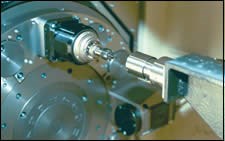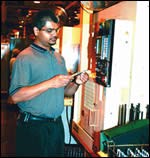Steering To Greater Flexibility
Re-tool aging dedicated machines? For this plant, it makes more sense to spend a bit more to replace them with new, more flexible, machining centers.
"Sure, a dedicated machine delivers faster cycle times, but when it goes down, production stops until the machine is repaired. And for what it costs to re-tool that dedicated machine for another job, you can almost buy a new, more flexible, CNC machine that is better suited to today's production requirements." If you get the feeling from the above remarks that dedicated machine tools are on the way out at Visteon's Chassis plant in Indianapolis, Indiana, you're right.
The plant, which specializes in the production of power rack and pinion steering gear assemblies for passenger cars and trucks, has eliminated about half of the dial index machines used to produce input shafts, a critical component of a power steering valve. And as the input shaft jobs running on the remaining dial index machines end or change, the plant expects to retire them, rather than re-tool them, as well.
The input shaft is a cylindrical steel component, about 6 inches long by 1 inch in diameter, machined from barstock. It requires numerous operations, including an "Op 80," in which multiple holes (hydraulic fluid passages) are drilled through the OD to a main bore running the length of the part.
At one time, the input valves were drilled almost exclusively on automatic dial index machines. Recently, however, the Visteon plant received an order for a new rack and pinion steering gear assembly with an input shaft that required an unusually small (1.5-mm diameter) hole. At a staff meeting to discuss the new job, the drill supplier advised that the small hole would have to be drilled at a higher rpm than the dial index machines were capable of, so the staff began considering alternate ways of producing the hole.
"We have a large number of dedicated machines in the plant, and there was a growing awareness that the time and cost involved in setting up the machines for different jobs greatly limited our efficiency and flexibility," explains Wahid Kapadia, a member of the Forward Models Engineering department. "We started looking for a CNC machine to drill the small hole for a number of reasons. First, many CNC machines offer the spindle speeds that we needed to drill the hole. Second, small drills are vulnerable to breakage, and CNC machines offer the tool control needed to minimize the problem.
"Third, we are very concerned about maintaining production rates," he continues. "When a problem arises on a dedicated machine, production stops and does not start again until the problem is solved. On the other hand, when production is spread over several standard CNC machine tools, if one machine develops a problem, the other machines continue to make parts, and although production is affected, it isn't completely stopped."
The plant first considered a CNC lathe with live tooling. However, it was unable to find a machine that offered the drilling speed required for the small hole.
Next, the plant looked at standard CNC drilling and tapping machines. Several such machines would be needed to satisfy the production volumes involved. However, because the machines would run in a largely unattended mode, some add-ons would be required to equip them for the job. One or more robots would be needed to automate the loading-unloading of parts. An indexing workholder would also be needed to index the input shaft in 90-degree increments for drilling. The prospect of buying the machines and fitting them with the workhandling equipment needed for the job was becoming daunting. A simpler solution was desired.
After more research, the plant investigated the A-Series machining centers made by Wasino Corp. U.S.A. (Rolling Meadows, Illinois). The A-Series consists of four-axis (X, Y, Z and C) machining centers with secondary turning capability. Configured more like automated turning machines than conventional machining centers, the series has a horizontal, 4,000-rpm spindle with a C axis that is programmable in 0.0001 inch increments. The spindle is served by a tool turret, which can accommodate a rotary or turning tool at each tool station.
The A-Series machines also feature an integral gantry loader that takes parts to be machined from, and returns machined parts to, a compact, carousel-like staging area at the rear of the machine. The machines come with chucks up to 10 inches (for the largest model) for handling discrete parts, as well as a spindle bore that permits feeding barstock or extrusions to the machine from a bar feeder.
One of the most important features of the machine to Visteon was that the tool turret could directly drive (with no gearing) rotary tools to speeds up to 10,000 rpm, providing the speed to drill the small hole needed for the new input shaft. Accordingly, the plant purchased the A-12 model (for 12 turret tools). To make certain that the plant would have adequate drilling speed for current and future jobs, it purchased the machine with a speeder head that doubled the maximum speed capability to 20,000 rpm.
Made For The Part
"The main spindle offered a C axis, which conveniently took care of our need to index the part for drilling," Mr. Kapadia says. "And, the machine's integral gantry satisfied our need to automatically load and unload the parts. The off-the-shelf A-12 so completely met our needs for the job that it's as if it had been made for the part."
Initially, plans called for continuing to run the input shaft on the dial index machine and to machine the small hole on the CNC machine in a separate operation. However, the CNC was able to drill all of the holes, and by using it to do so, the plant was able to avoid drilling the small hole as a separate operation. The CNC machine completely replaced the dial index machine for the drilling of the input shaft.
The scenario was repeated when the plant received an order for power steering units for a popular pickup truck. Initially, the plan called for drilling the input shafts for the new job on the plant's dial index machines. However, further analysis indicated that re-tooling the machines to run the new job would be cost prohibitive, and that it would be more cost-effective to drill the input shafts on new CNC machines. Accordingly, three more A-12s were purchased for the task.
Similarly, the plant purchased a fifth A-12 machine to do the work of two older dial index machines used to produce service parts. The two older machines were discarded.
The battery of CNC machines provides the plant with a level of production flexibility that the dial index machines could not provide. "All of the CNC machines are programmed to machine all of our input shafts," Mr. Kapadia explains. "That means we can run any part on any machine at any time."
The machining centers can also be used for odd jobs as they arise. For example, when a design change for a power steering unit called for shortening the length of an input shaft, the machining center used for service parts was quickly set up for the cutoff operation. Also, when a special job came up that required milling flats in the part, a machining center was quickly programmed and tooled to handle the job.
One Operator Tends Five Machines
At Visteon, the machining centers are arranged in a row. All five machines are tended by one operator whose main task is to keep their carousels stocked with raw parts. On the day we visited the plant, most of the machines were drilling holes of three different diameters in the input shafts: one 7.9-mm hole through parallel milled flats at one end of the part; eight 3-mm diameter holes, two each at 90-degree intervals along the OD; and two 1.5-mm diameter holes 180 degrees apart. All of the holes are through holes to a main bore running the length of the part. The turret indexes three times to present the appropriate tool to the input shaft, and the total cycle time for the part is 55 seconds.
At one time, the plant had six dial index machines used for drilling holes in input shafts. Machining centers have replaced three of those machines. The remaining machines are still in production, but when the jobs run out or design changes occur, they will not be re-tooled. They will be replaced with more machining centers.
Probe Automatically Adjusts Tool Offsets on Machining Centers
When Visteon's Indianapolis Chassis plant shifted away from dedicated dial index machines to machining centers for the drilling of input shafts for its power steering units, the newer technology enabled the plant to take advantage of a higher level of cutting tool control. The CNC machines drill thousands of holes per shift, and offset adjustments must be made from time to time to compensate for tool wear. The plant did not want its operators to have the responsibility for those changes. For one thing, one operator runs all five CNC machines and does not have time to be making tool offsets. Also, a mistake by the operator could result in out-of-tolerance parts or, just as bad, a crash that would take the machine out of production.
The problem was solved when the plant installed a Z-Nano probe on each machining center. The probe inspects each drill and automatically signals the machine control to compensate for detected tool wear. Made by Blum LMT Inc. (Erlanger, Kentucky), the Z-Nano probe combines a highly sensitive probe capable of measuring tools as small as 0.02 mm in diameter with software, compatible with all major CNC controls, that provides the instructions for the needed tool positioning change. The repeatability of the probe is 0.001 mm. Measurement data is transmitted directly from the probe to machine control via a protected cable.
In addition to better control of hole size and improved machine uptime, the probe also provides an opportunity for significant tool savings. The plant uses solid, TiN-coated carbide drills to drill the holes in the input shafts. "Until now, we have been using new drills exclusively," explains Visteon's Mr. Kapadia. "One of the reasons is that we did not want our operators adjusting offsets to compensate for the smaller size of re-ground drills. Now, because each machine is fitted with a probe that measures the drills and automatically makes the needed adjustments, there is nothing standing in the way of our using re-ground drills. A new drill costing as much as $50 can be sharpened at a fraction of the cost, for a significant savings for our department."
Related Content
7 CNC Parameters You Should Know
Parameters tell the CNC every little detail about the specific machine tool being used, and how all CNC features and functions are to be utilized.
Read MoreTips for Designing CNC Programs That Help Operators
The way a G-code program is formatted directly affects the productivity of the CNC people who use them. Design CNC programs that make CNC setup people and operators’ jobs easier.
Read More6 Steps to Take Before Creating a CNC Program
Any time saved by skipping preparation for programming can be easily lost when the program makes it to the machine. Follow these steps to ensure success.
Read MoreSwiss-Type Control Uses CNC Data to Improve Efficiency
Advanced controls for Swiss-type CNC lathes uses machine data to prevent tool collisions, saving setup time and scrap costs.
Read MoreRead Next
The Cut Scene: The Finer Details of Large-Format Machining
Small details and features can have an outsized impact on large parts, such as Barbco’s collapsible utility drill head.
Read More3 Mistakes That Cause CNC Programs to Fail
Despite enhancements to manufacturing technology, there are still issues today that can cause programs to fail. These failures can cause lost time, scrapped parts, damaged machines and even injured operators.
Read More











.jpg;maxWidth=300;quality=90)








.png;maxWidth=300;quality=90)












.jpg;maxWidth=970;quality=90)